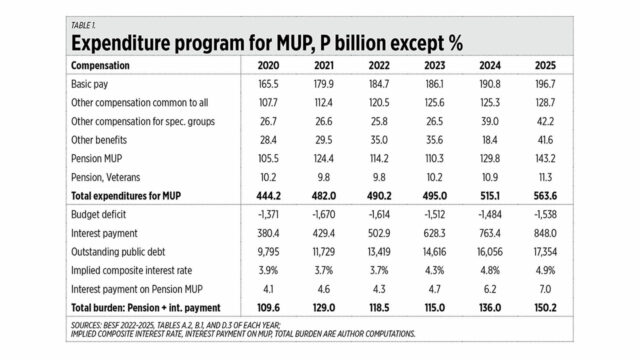Entertainment (08/20/24)
Ayala Malls Cinemas presents Thrill Fest this Ghost Month
IN some Asian cultures, the observance of Ghost Month every August is a time-honored tradition. It is said that during this time, the spirits of the dead come to visit the living. In celebration of this tradition, Ayala Malls Cinemas’ “Thrill Fest: The Ghost Month Classic Film Series” will present a lineup of four classic thriller movies from Aug. 21 to Sept. 3. The films are celebrating their anniversaries this year: Interview with the Vampire’s 30th anniversary, Gremlins’ 40th anniversary, A Nightmare on Elm Street’s 40th anniversary, and The Towering Inferno’s 50th anniversary. They are all not currently available on popular streaming platforms and can be watched at the following Ayala Malls Cinemas: Glorietta, Greenbelt, Circuit, Market! Market!, Fairview Terraces, Feliz, Trinoma, UP Town Center, Manila Bay, Harbor Point, Solenad, Ayala Center Cebu, Centrio, and Capitol Central. Thrill Fest movie tickets will have a special price — only P200 to P250.
Toy Kingdom Toy Expo to be held at SMX Convention Center
KIDS will be pleased to return to the much-awaited Toy Expo from Aug. 22 to 25. At the SMX Convention Center Manila, they can join in the four days of pure fun at the immersive event that showcases a world of toys. Trending brands like Bluey, Funko Pop, Mario Bros, Pop Mart, Pokemon, Squishmallows, Sunrisepop, Yolopark, and Zuru will be there, along with nostalgic favorites such as Care Bears, Sanrio, Sesame Street, and Voltes V. Beloved classics include Barbie, Crayola, Disney, DC, Gundam, Hot Wheels, Lego, Marvel, Minions, Star Wars, and many more. There will be a series of meet-and-greets featuring popular characters, exclusive toy launches, limited edition toys, surprise bundles, and daily raffle for all guests. For more details, visit Toy KingdomPH on social media.
Araneta City salutes heroes through art
TO commemorate Ninoy Aquino Day and National Heroes’ Day, Araneta City, in partnership with Upsilon Sigma Phi and Sigma Delta Phi will be presenting a special public forum. Esteemed artists who have made significant contributions to culture and the arts will be guesting at the event. They are Kidlat Tahimik, National Artist for Film; Gemino H. Abad, National Artist for Literature; Alfred Vargas, FAMAS Best Actor; and Gabriel Malvar, award-winning documentary filmmaker. The public forum is free and open to all on Aug. 21, 5 p.m., at the Quantum Skyview of Gateway Mall 2, Quezon City.
SB19 drops The First Take versions of ‘Gento’ and ‘Mapa’
P-POP boy group SB19 has released “Gento” and “Mapa” from The First Take sessions on all digital music platforms via Sony Music Entertainment. The new versions feature the award-winning group’s performance at The First Take, a popular YouTube channel with nearly 10 million subscribers. The show’s format features Japanese and international music guests performing a song in one take, filmed with shots of the artists and a microphone against a minimalist and usually white backdrop. To date, The First Take renditions of “Gento” and “Mapa” have amassed more than 4.5 million views on YouTube. SB19 was the first Southeast Asian group and the first Filipino artist to be invited on the globally renowned platform.
NewJeans to headline Coke Studio Philippines concert
FOR Season 8 of Coke Studio Philippines, the Ultimate Fandom Concert on Sept. 5 at the SM Mall of Asia Arena will have a star-studded lineup for its fans. K-pop girl group NewJeans was announced as one of its main artists. Locally, its featured artists include P-Pop powerhouse Alamat, Gen Z performer and actor Kyle Echarri, hip-hop hitmaker Nik Makino, and rising rebel rapper Illest Morena. They’ll be performing their collaboration songs for this season for the first time at the concert, along with “Hugot King” and first-ever Filipino Coke Studio global artist Zack Tabudlo.
Thai tearjerker How to Make Millions Before Grandma Dies to stream on Netflix
THE THAI drama How to Make Millions Before Grandma Dies is bringing a tender plot on Netflix across Southeast Asia starting Sept. 12. The highest-grossing Thai film in numerous countries, including Indonesia, Singapore, Philippines, Malaysia, and Myanmar, stars Putthipong “Billkin” Assaratanakul as game caster M, who is driven by the desire for a multimillion-dollar inheritance to care for his terminally ill grandmother played by Usha Seamkhum. Produced by GDH 559, How to Make Millions Before Grandma Dies was written by Thodsapon Thiptinnakorn, who drew inspiration from personal experiences, and Pat Boonnitipat, known for the hit Thai film Bad Genius. It streams on Netflix starting Sept. 12.
Kai Del Rio announces first headline show in nearly a decade
FILIPINO indie artist Kai Del Rio (formerly known as Kai Honasan) will be having a headline show in September, alongside the launch of back-to-back singles “Ang Nag-iisa” and “Storm Like Me.” Her first solo headline show in nearly a decade, the Sept. 13 intimate concert will also mark her first time to perform the upcoming dual singles. It will take place at Sari Sari Bar in Makati City. “Ang Nag-iisa,” to be released that same day, will be a gritty blues and alt-rock track while “Storm Like Me,” to be released on Sept. 20, will take listeners back to her acoustic, stripped-down roots. The show and the singles serve as a reintroduction of the indie singer-songwriter, complete with a new moniker, a new record label, and a new management team. Ms. Del Rio is co-producing the official launch alongside GNN Entertainment Productions and Locked Down Entertainment, with backing from Lightfirst and Underdog Music. Tickets are now available on bit.ly/kaidrlaunch.
Cinemalaya announces entries for 2025 edition
FOLLOWING the recently-concluded Cinemalaya Bente: Loob Lalim Lakas, the Cultural Center of the Philippines and the Cinemalaya Foundation, Inc. have already announced the 10 new full-length finalists who will be competing next year. They are: Abanse by Chad Vidanes, Bloom Where You Are Planted by Noni Abao, Child No. 82 by Tim Rone Villanueva, Cinemartyrs by Sari Dalena, Habang Nilalamon ng Hydra ang Kasaysayan by Dustin Celestino, Open Endings by Nigel Santos and Keavy Eunice Vicente, Padamlagan by Jenn Romano, Paglilitis by Raymund Barcelon and Cheska Marfori, Republika ng Pipolipinas by Renei Dimla, and Warla by Kevin Alambra and Arah Badayos.
Ely Buendia releases single ahead of solo concert at Newport
FORMER Eraserheads frontman Ely Buendia remains active with his latest single as proof. His new, fuzzy, alt-rock track “Bulaklak sa Buwan” serves as the first single off his upcoming sophomore album, Method Adaptor, which will be out in November. The track’s release coincides with the prevalence of fabricated stories and propaganda-driven atrocities in online spaces, challenging listeners to raise awareness for factual truth and combat misinformation. Meanwhile, this September, fans will have the rare chance to witness the rock icon perform his greatest hits live at the Newport Performing Arts Theater. The one-night solo concert on Sept. 14, directed by Jamie Wilson, will feature tracks from Mr. Buendia’s Eraserheads days as well as more recent hits. Tickets are now available at all TicketWorld outlets, with prices ranging from P1,500 to P8,800.
Gloc-9 releases new heart-wrenching single
PROLIFIC rapper-songwriter Gloc-9 has a new song out called “Ala.” The fresh single is deeply emotional, with themes of love, family, and the fragility of memory. The title, a wordplay of the Filipino word “alaala,” (memories), hints at a journey of a man who reflects on his cherished love story slowly fading away in his mind due to Alzheimer’s. The rap song is part of the latest New Music Friday Philippines and Bago sa Kalye playlists on Spotify. “Ala” is now available on all digital music streaming platforms.
Wi Ha Jun’s fan meet in Manila announces upgraded perks
FANS of Wi Ha Jun will have jam-packed benefits at the upcoming “WI HA JUN 2024 Fan Meeting Tour <A Wively Day> in Manila” on Sept. 15 at the New Frontier Theater, Quezon City. All ticket holders are entitled to a group photo session, a hi-touch session, and photocards. Meanwhile, VIP ticket holders can avail of the on-site fan signing event and a one-on-one photoshoot for VIP ticket holders. The Manila show is presented by Ovation Productions and Applewood. Tickets are available at ticketnet.com, with prices ranging from P4,500 to P10,500.
The Itchyworms announce first-ever Canada tour
ONE of the Philippines’ most familiar bands, The Itchyworms, are hitting the road for their first-ever Canadian tour this November. “Akin Ka Na Lang Canada” will traverse four cities: Vancouver, Calgary, Winnipeg, and Toronto. The tour marks a special reunion with the band’s original guitarist, Chino Singson, who is now based in Vancouver, and who last toured with the Itchyworms in the United States in March 2023. It also serves as a heartfelt farewell to the band’s newest member, Mikey Amistoso, who joined in recent years but is now migrating to Toronto. The dates are Nov. 1 in Vancouver, Nov. 3 in Calgary, Nov. 8 in Winnipeg, and Nov. 10, in Toronto, with tickets available via Simpletix and Ticketmaster.















